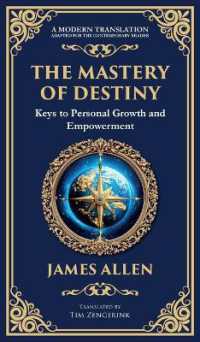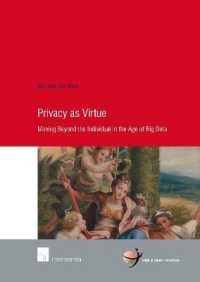Full Description
The edited volume, Digital Video Composing: Multimodal Teaching & Assessment, provides an in-depth examination of teachers' intentional use of learning, teaching, and assessment practices with digital video (DV) across a range of educational contexts. As a versatile multimodal educational tool, DV has become ubiquitous in twenty-first-century culture, allowing users to produce, share, and view others' work.
The chapters in this book contain grounded portrayals using DV for in-school, out-of-school, and online educational contexts across a range of ages. Divided into three sections—foundational aspects of DV, portraits of educational practice, and DV in teacher preparation and professional development—the chapters present tangible examples of DV educational applications that promote critical and constructive thinking and life-long learning. The authors employ various frameworks—including multimodality, semiotics, anti-racism, critical literacies, trauma-informed care, and critical media literacy—while exploring a range of subject matter. Chapter topics include rhetorical features and affordances of reading and composing with DV, cultural counterstories, social and political inquiry and critiques, and connections between print and video.
Together, these examples of research and practice represent a montage of how DV is being used across different multimodal learning spaces, including urban, rural, and online settings.
Contents
Section 1. Learning about DV: Foundational Aspects
Chapter 1. Multimodal and Semiotic Approaches to the Interpretation of Student-Produced Digital Videos; Jason Ranker
Chapter 2. Teaching with Streaming Media in Elementary School in the Age of Censorship Legislation; Damiana Gibbons Pyles
Chapter 3. Behind the Lens: Translating Scholarly Video Production into Pedagogy; Ben McCorkle and J Palmeri
Section 2. Learning with DV: Portraits of Practice
Chapter 4. Abolitionist Content Creator: The Use of Tik-Tok to Tell Digital Counternarratives Around Black Wellness and Abolition in the Era of Black Lives Matter and Global Catastrophe; William O'Neil-White
Chapter 5. Conchcasting: Using Podcasting to Deepen the Connection to Literary Themes and Understanding in Literary Works; Jordan Thoennes
Chapter 6. Youth Framing of Climate Change through Video Production; Richard Beach, Blaine E. Smith, Daniela Torres Cirina, and Sanjukta Sarkar
Chapter 7. Documentary Rhetorics and Public Pedagogy: Teaching An Inconvenient Truth; Russell Mayo
Chapter 8. Reflecting and Composing with Video at Hand; Jason D. DeHart
Chapter 9. Dream Big! - Play and Trauma-Informed Digital Video Composition with Rural Youth; Nichole Barrett
Chapter 10. DV, Content Creation, and the Challenge of Teaching English in the 21st Century; James E. Cercone and Milly S. Clark
Section 3. Learning and Adapting through DV: Teacher Preparation & Professional Development
Chapter 11. Teaching and Assessing Visual Storytelling Techniques for Multimodal Composing with a Digital Camera or Phone; Ewa McGrail and J. Patrick McGrail
Chapter 12. Let's Tok about it: Using Digital Video (DV) Creation to Transform Book Talks in a Young Adult Literature Methods Course; Nicole Damico
Chapter 13. Cultivating Complex Climate Understandings through Digital Video Response; Candance Doerr-Stevens








